We are hugely excited to announce a 66% increase in the number of wines with full Wine Lister scores, to a total of 3,140 wines and just shy of 30,000 wine-vintages. That means you are now far more likely to find the wine you are looking for when searching the Wine Lister database.
In a survey, Wine Lister subscribers said they wanted increased wine coverage on the website, allowing them to discover Wine Lister scores and decision-making tools on a broader range of fine wines, and we have worked hard to make this happen.
This important development comes thanks to the expansion of Wine Lister’s data partnerships with Wine Market Journal and Wine Owners, the former supplying unparalleled auction trading data from the world’s major fine wine auction houses, and the latter comprehensive price data.
In particular, Wine Lister’s coverage of Burgundy’s top wines has greatly increased, with 58% of the newly-scored wines hailing from the region. However, the overall top 10 highest-scoring wines in this new batch show a thrilling level of variety:
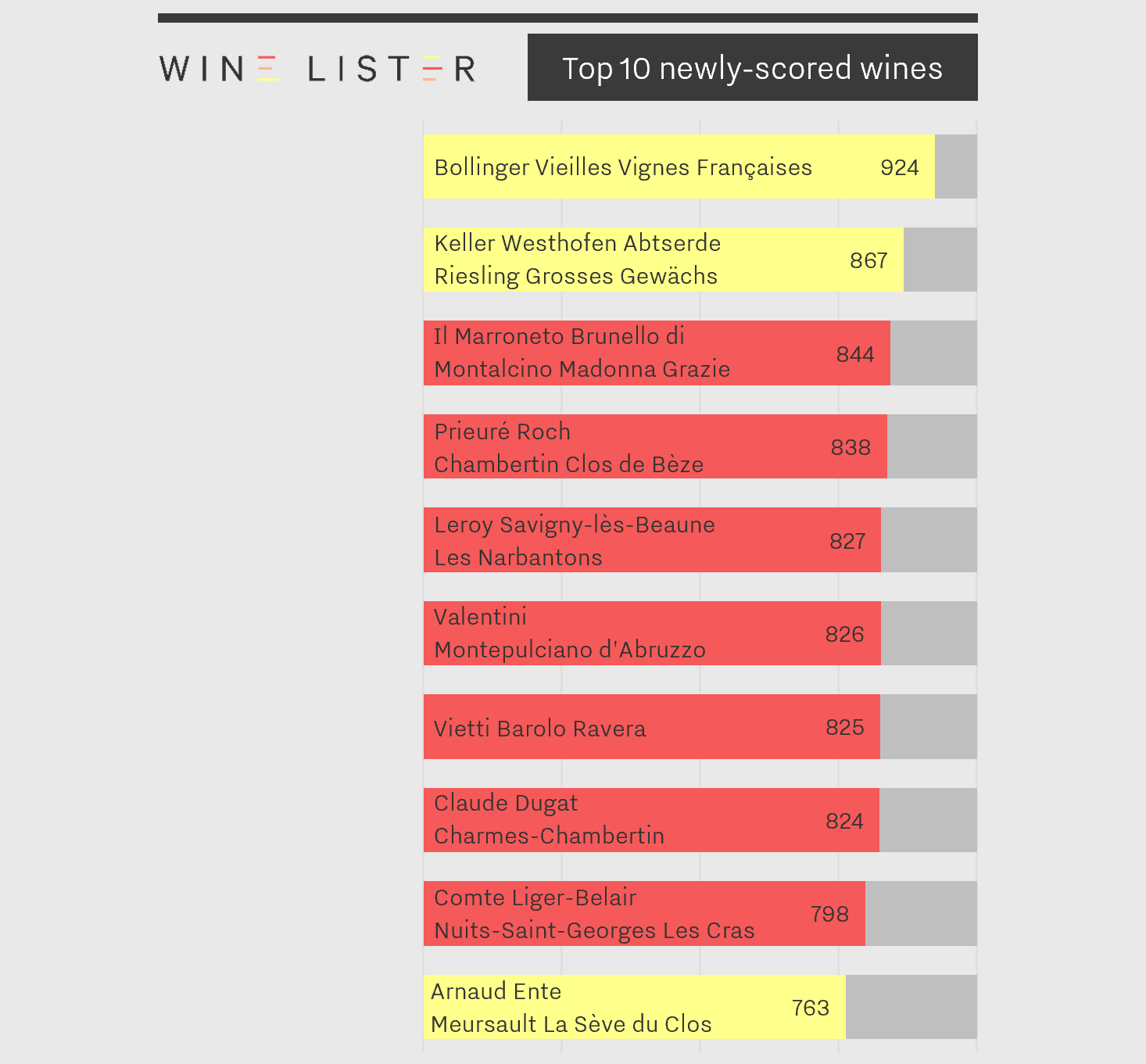
Users can now find out everything they need to know about wines such as Bollinger’s hallowed pre-phylloxera Vieilles Vignes Françaises, to Keller’s Westhofen Absterde Riesling, Valentini’s ultra-traditional Montepulciano d’Abruzzo, and back to some Côte d’Or heavyweights via top Brunello and Barolo from Il Marroneto and Vietti. The top 10 newly-scored wines confirm the rich diversity of wines on Wine Lister.
This coverage expansion is the first step in a series of exciting developments that Wine Lister has in store over the coming months, as it approaches its third birthday in May 2019. Each one is designed to help the different facets of the international fine wine community to get the most out of our unparalleled database and intelligence. Watch this space!
Wine Lister Indicators are designed to help you find the perfect fine wine for any occasion. Wine Lister regularly tracks the movements of wines in and out of these segments (such as recent commentary featuring new Buzz Brands for Burgundy). This month we look at newcomers to the Value Pick segment – wines that achieve the best quality to price ratio.
France is the geographical victor of new Value Picks, with a total of seven wines hailing from Bordeaux and the Rhône (and one from the Loire). These traditional regions may appear “uncool” compared with the likes of Burgundy (whose popularity continues to rise). However, it is perhaps thanks in part to their “uncool” status that Bordeaux and the Rhône are also sources of exceptional value for money.
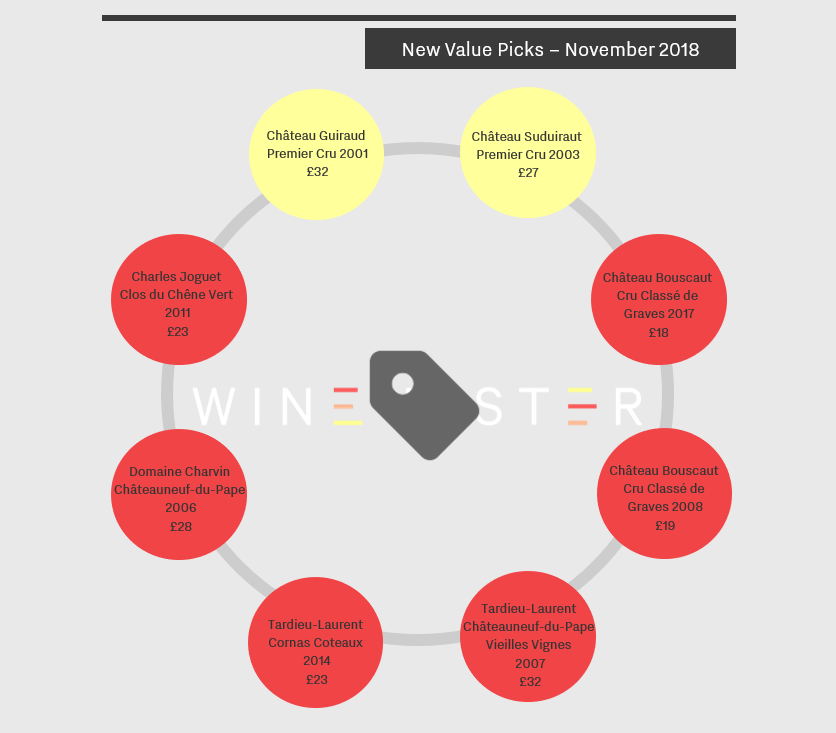
The only two whites of our new Value Picks, Château Guiraud Premier Cru 2001 and Château Suduiraut Premier Cru 2003, actually achieve the highest Quality scores of the group (936 and 929 respectively). Château Guiraud 2001 is priced at £32 per bottle in-bond, and Château Suduiraut 2003 at £27. Sadly, the incredible Quality scores of these Sauternes (as well as others across the board) may be hindered by a lack of demand for the volume produced. Sauternes typically earn poor Economics scores on Wine Lister (Château Guiraud 2001 achieves an Economics score of 212, and Château Suduiraut 2003 345), perhaps due to the pace at which older vintages of these exceptional sweet wines are consumed. With Christmas just around the corner, however, there is every reason to source either of these two for good value for your buck.
Elsewhere in Bordeaux, Pessac-Léognan rules the Value Pick reds with two listings from Château Bouscaut. The 2017 is one of Bouscaut’s new Value Pick vintages, however the real appeal, with 10 years of age, is the physical 2008 vintage, which achieves a Quality score of 768 (vs. 775 for 2017) for a price just £1 above the latest release (at £19 per bottle in-bond). These two vintages join existing Value Picks of Château Bouscaut, namely the 2016, 2015, 2013, and 2004. The latter is interestingly Bouscaut’s highest-scoring vintage ever (868), and therefore provides exceptional value at £21 per bottle in-bond.
In the Rhône, producer Tardieu-Laurent has two newcomers to the Value Pick segment: Châteauneuf-du-Pape Vieilles Vignes 2007 (£32) and Cornas Coteaux 2014 (£23), with Quality scores of 906 and 813 respectively. The Châteauneuf-du-Pape Vieilles Vignes now has an impressive six Value Pick vintages, and the Cornas Coteaux four. Indeed, Tardieu-Laurent (which was recently acquired by EPI, the owner of top Brunello producer Biondi-Santi and both Piper and Charles Heidsieck) appears a good producer to choose for value, with six of the domaine’s ten wines on Wine Lister having vintages in the Value Pick segment. It is perhaps therefore surprising that its Brand scores sit mostly in the average section of Wine Lister’s 1,000-point scale or below – uncool, but with very cool price to quality ratios.
A second Châteauneuf-du-Pape, the 2006 from Domaine Charvin is the third wine from the Rhône to make it to the list, with a Quality score of 869 and available at the modest price of £28 per bottle in-bond.
These French Value Picks convince us that “old-school” wines should not be dismissed as such. With an average price of £25 per bottle in-bond, and an average Quality score of 858, these represent excellent value for money – and that will always be cool.
Last week we revealed the top 20 gainers in presence in the world’s best restaurants over the past 12 months. That was in terms of breadth, i.e. the number of restaurants in which a wine features. Wine Lister also analyses the depth of presence – the range of vintages and/or bottle formats of each wine therein. Here we look at the top 21 wines achieving the largest increases in restaurant presence depth since last year.
In first place, with an impressive 35 additional vintages and/or bottle formats listed across the world’s 150 best restaurants since this time last year, is Vega-Sicilia’s Unico. This brings its total references to 250 (almost three and a half in each of the 71 lists in which it features). Given Unico’s average drinking life span of 13 years, and its reputation for longevity (an Unico vertical tasting is an opportunity not to be missed), this result is hardly surprising. Its strong restaurant presence is matched by online popularity (Unico is the 33rd most-searched-for wine in our database), resulting in a Brand score of 992 – the best of any Spanish wine on Wine Lister.
Though Spain takes the number one spot, Italy is the overall biggest mover in increased depth of representation, claiming 12 out of the 21 places shown on the chart below.
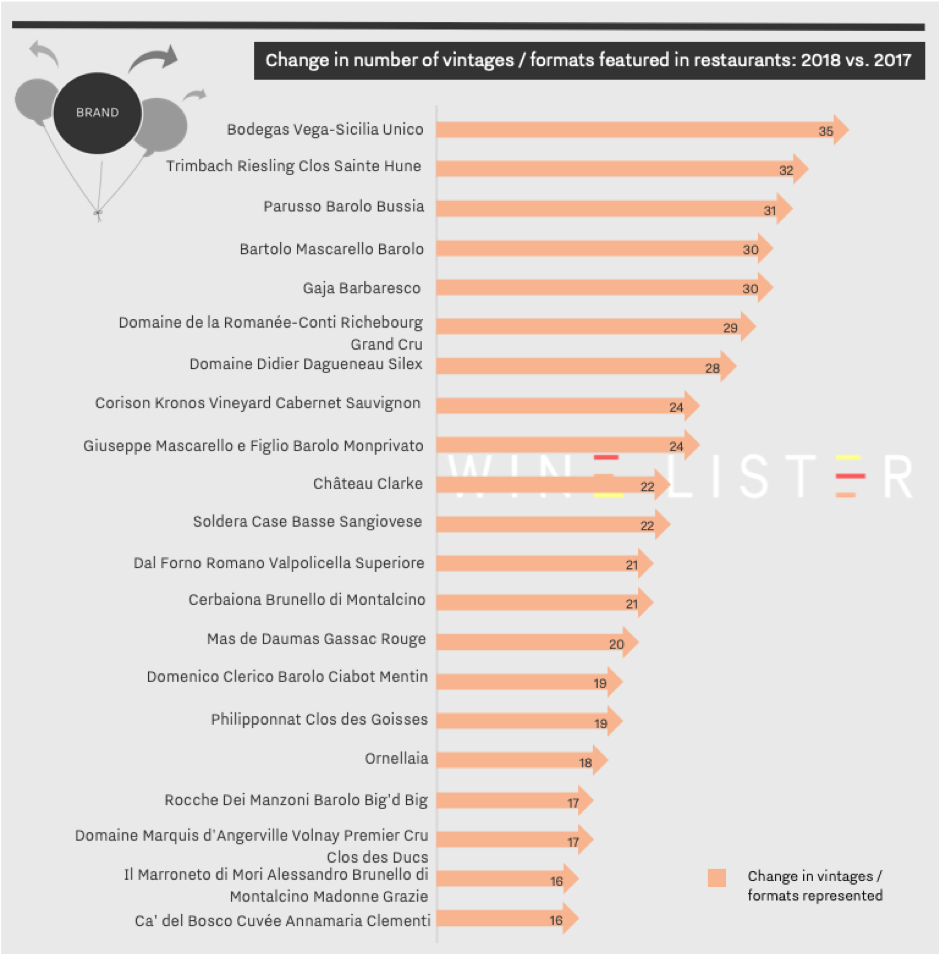
Ornellaia is among these, and is also the most thoroughly represented wine of the group, with 280 vintages and/or bottle formats featured across 43% of the world’s best restaurants.
Several others – Cerbaiona Brunello, Dal Forno Romano Valpolicella Superiore, Ca’ del Bosco Cuvée Annamaria Clementi, and Domenico Clerico Barolo Ciabot Mentin – feature in the top gainers for horizontal as well as vertical presence in the world’s best restaurants. The latter is one of five Barolos to feature in the chart above, joined by Parusso Barolo Bussia, Bartolo Mascarello’s Barolo, Giuseppe Mascarello e Figlio Barolo Monprivato, and finally, Rocche Dei Manzoni Barolo Big’d Big, which sees the biggest increase in vertical presence of the whole group. Despite a horizontal representation increase of just 1%, the number of vintages and/or bottle formats listed across the 3% of the world’s best restaurants in which it features has grown from two to 19 in the last 12 months (or in other words, by 850%).
Outside Italy, the overall picture of restaurant presence depth somewhat contradicts that of breadth painted last week. Though Champagnes, and in particular grower offerings, have increased significantly in terms of horizontal presence, their vintage and/or format gains have not been sufficient to make this week’s top 20. This suggests that whilst sommeliers are keen to add more variety of Champagne, they aren’t so worried about listing reams of vintages / formats thereof. Only one Champagne features in the group: Philipponnat’s Clos des Goisses.
Bordeaux is conspicuous by its absence in this list, other than Château Clarke, with 26 overall references up from just four. In fact, Bordeaux’s big names are more likely to find themselves at the very bottom of the list, many having seen their vertical entries on restaurant wine lists shrink significantly. This seems to suggest that as restaurants diversify, they are choosing to hold less Bordeaux stock, still listing the top wines, but not necessarily in multiple vintages or formats.
Part of Wine Lister’s Brand score includes a measure of prestige, achieved by analysing a wine’s presence in the world’s best restaurants. Whether a restaurant makes the cut depend on a combination of measures including the Michelin Guide, San Pellegrino 50 Best Restaurants, and World of Fine Wine Best Wine List Awards.
The chosen wine lists are then analysed to give us the breadth (how many restaurants) and depth (how many formats and/or vintages in each restaurant) of presence achieved by each wine on Wine Lister. Looking at the former criterion, the chart below shows the top 20 biggest gainers since our last blog on the subject. (Next week we will be looking at wines with the greatest increase in depth of representation.)
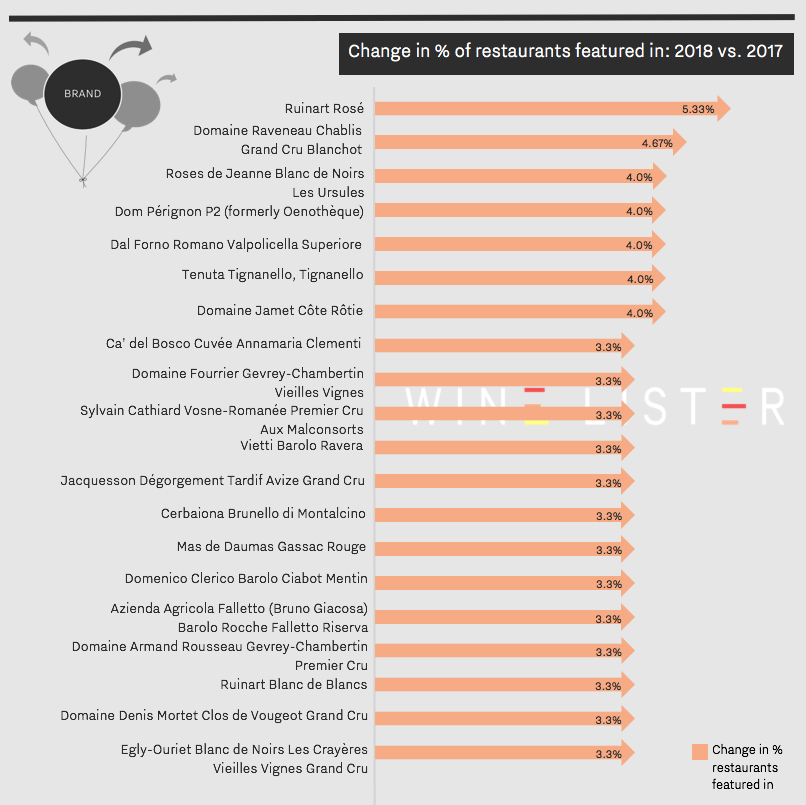
Six out of the 20 wines with the biggest increase in restaurant presence are Champagnes. Ruinart appears twice, with its NV rosé having made the greatest improvement, now appearing in 33% of the world’s best restaurants. However, the overall winner – present in more than double the number of restaurants, is Dom Pérignon’s Vintage Brut. Despite not featuring in the top 20 biggest risers above, the Champagne Brand king is now present in 69% of top restaurants worldwide, overtaking last year’s winner, Yquem.
Contrary to our last analysis on the subject, not all the biggest Champagne gainers in restaurant presence are big brands. Ruinart Rosé, Dom Pérignon P2, and Ruinart Blanc de Blancs may well fit this bill, with an average Brand score of 878, but the lesser-known three, grower Champagnes Roses de Jeanne Blanc de Noirs Les Ursules, Jacquesson Dégorgement Tardif Avize Grand Cru, and Egly-Ouriet Blanc de Noirs Les Crayères Vieilles Vignes, do not, as shown by a lower collective Brand score average of 664.
If this alone is not an indication of restaurant wine lists branching out, then perhaps the absence of Bordeaux is (indeed, a handful of Bordeaux wines with strong restaurant presence have lost a little ground since last year’s analysis). This diversification does however appear exclusive to the Old World, with no New World wines in the top 20 gainers.
Burgundy is well-represented amongst the top gainers, with one white, Raveneau’s Chablis Blanchot, and four reds: Sylvain Cathiard’s Vosne-Romanée Aux Malconsorts, Denis Mortet’s Clos de Vougeot, Armand Rousseau’s Gevrey-Chambertin, and Fourrier’s Gevrey Chambertin Vieilles Vignes.
Italy brings a show of diversity with six wines hailing from four different appellations across the 20 biggest movers. Vietti’s Barolo Ravera – one of three Barolos to feature in this list – has the lowest restaurant presence of the group (5%) and Solaia’s younger sibling, Tignanello the highest (47%).
Wine Lister periodically studies the movements of wines in and out of the four Wine Lister Indicator categories. One of these, Buzz Brands, denotes wines that achieve outstanding online popularity (measured through search rankings based on monthly searches on Wine-Searcher), and presence in the world’s best restaurants.
After analysing newcomers to the Buzz Brand segment in June, Burgundy dominates once again in our findings for October. Red Burgundy, and in particular, Gevrey-Chambertin, takes three out of the four places of this month’s new Buzz Brands.
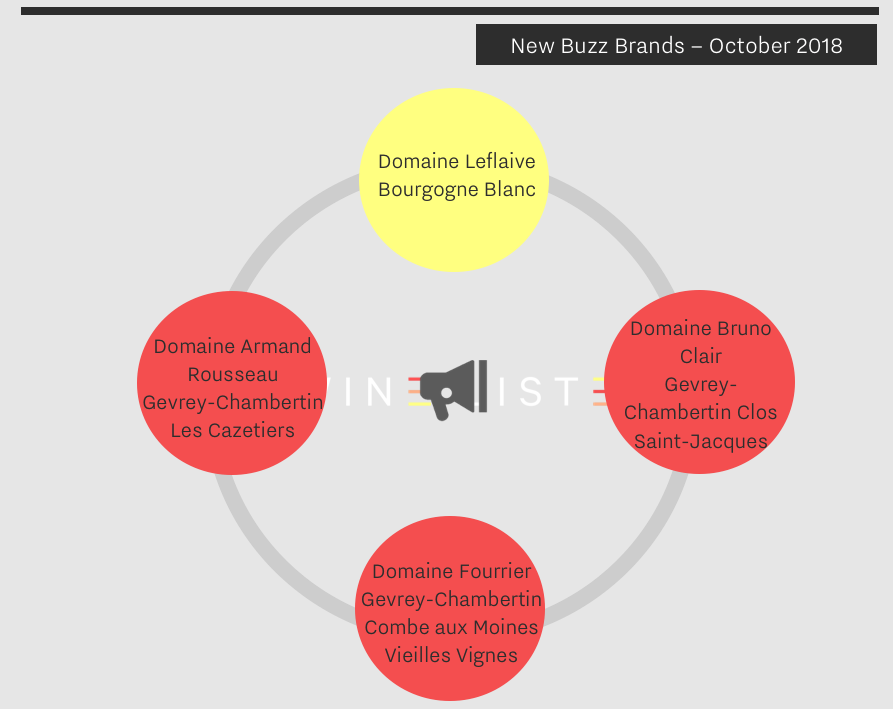
However, it is in fact the only white, Domaine Leflaive’s Bourgogne Blanc, that achieves the highest Brand score of the group at 815. All of the Domaine Leflaive wines on Wine Lister are now Buzz Brands but one – their most expensive Grand Cru, Montrachet (at £6,059 per bottle compared with £218, the average price of the rest). Indicative, maybe, of drinkers being priced out of the top wines and refocussing their interest lower down the ladder.
Perhaps it is also the sign of a good brand strategy in action, with the rising profile of the Domaine’s top wines filtering all the way down to the regional wines, via the premiers crus. The new addition of the regional offering here follows two previous new Leflaive mentions in Wine Lister’s last Buzz Brand audit (of Puligny-Montrachet Les Combettes and Meursault Sous le Dos d’Ane).
Of the three reds, two hold the same Brand score of 722, and near identical Brand profiles (see restaurant presence and search rank in the image below). The Gevrey-Chambertin Clos Saint-Jacques is the first of Bruno Clair’s wines to become a Buzz Brand. Domaine Fourrier’s Combe aux Moines Vieilles Vignes has the highest Quality score of all three new red Burgundy Buzz Brands with a score of 889. This, coupled with a slightly better Economics score helps bring it very slightly ahead for overall Wine Lister score.

Though Domaine Armand Rousseau’s Les Cazetiers is third of the Gevrey group qualitatively, it is geographically sandwiched between the first two. These wines together form a neat representation of three of the best premier cru vineyards of Gevrey-Chambertin. Incidentally, this is the last of Rousseau’s wines on Wine Lister to achieve Buzz Brand status. The domaine’s highest Brand score is won by the better-known Clos Saint-Jacques (unsurprising given that it owns roughly one third of the entire vineyard parcel) with a Brand score of 964.
As part of our Brand score, Wine Lister measures popularity using the three-month rolling average searches on the world’s most visited wine site, Wine-Searcher.
We have recently updated our treatment of this data to provide relative results for all 4,000+ wines on Wine Lister. Expressing each wine’s search frequency as a ranking will make it easier for our users to interpret the data. For example, Mouton is the #1 most searched-for wine of all wines on Wine Lister, according to monthly searches on Wine-Searcher.
To mark this transition, here we examine the top 50 most popular fine wines in the world.
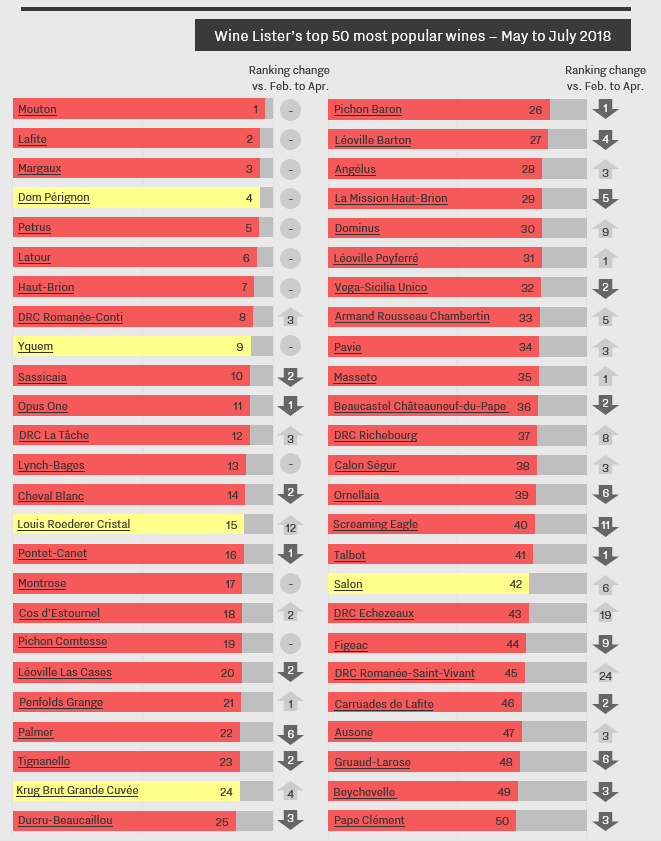
The first seven most searched-for wines for the period of May, June, and July include the five Bordeaux left bank first growths (Mouton, Lafite, Margaux, Latour, and Haut-Brion), right-bank powerhouse, Petrus, and Champagne super-brand, Dom Pérignon. It is perhaps of no surprise that these rankings remain unchanged since the previous period (February to April) .
Burgundian searches in the top 50 are dominated by Domaine de la Romanée-Conti, with Romanée-Conti, La Tâche, Echezeaux, and Romanée-Saint-Vivant all achieving better rankings versus the previous period. These four together achieve an average ranking of 30th place, and an average movement up the search ranking of 11 places.
Other than Dom Pérignon, the two remaining Champagnes featured in the top 50 most searched-for wines have moved up the rankings for May-July 2018 compared to the previous three-month period. Louis Roederer’s Cristal was up 12 places, presumably due to the release of its 2008 vintage in June. Krug’s most recent Grande Cuvée (166th edition) was released in late May, explaining its jump four spots up the rankings into 24th place.
More than half of the top 50 most popular wines are Bordeaux, with 30 wines hailing from the region. However, Bordeaux did not see the boost to their search ranking one might have expected during Bordeaux’s en primeur 2017, with one fewer of the region’s wines featuring in the top 50 than before the campaign kicked off. In fact, supporting Wine Lister’s analysis of this year’s lacklustre campaign, searches for many top Bordeaux châteaux actually fell during this period. For instance, Figeac, despite achieving Bordeaux’s 10th best Quality score of the 2017 vintage, slipped nine spots down the rankings.
Our in-depth study of Burgundy earlier this year showed that its prices continue to rise at a faster pace than those of any other fine wine region. With such high prices and tiny availability, wine buyers seeking good value drinking wines may often find their cellar a little light on Burgundy.
However, alongside the virtually unattainable wines at the most prestigious end of the Burgundy scale, there are some Value Picks to be found.
One of four Wine Lister Indicators, Value Picks are wines with the best quality to price ratios. Wine Lister’s proprietary Value Pick algorithm allows more expensive wines with exceptional quality to shine by reducing the impact of price in calculating the ratio.
The simple answer to good value for white Burgundy is Chablis.
For exceptional value at everyday drinking level in particular, Domaine William Fèvre stands out. Seven out of the last eight vintages of the domaine’s straight Chablis are identified as Value Picks, with prices per bottle under £13 and an average Quality score of 553 (above average on Wine Lister’s 1000-point scale).
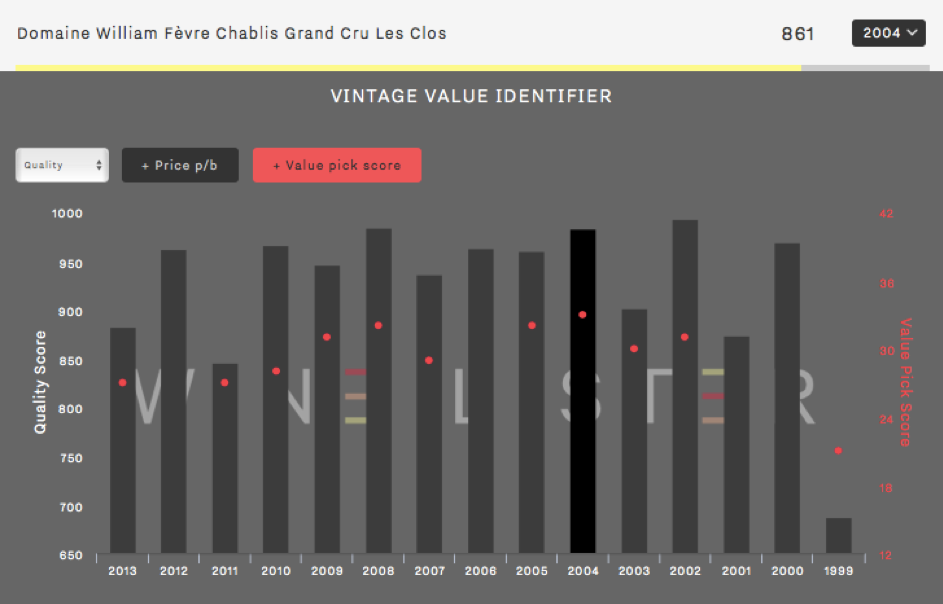
Moving up the price ladder, Domaine William Fèvre’s Chablis Grand Crus Les Clos 2004 shows exceptional value, with a price per bottle of £50 and a Quality score of 982 – shown in the Vintage Value Identifier chart above. At a comparative score (979) for white burgundy in 2004 we find Domaine Leroy’s Corton-Charlemagne Grand Cru, with a price tag 60 times higher – £3,005 per bottle.
Chablis make up all top 10 white Burgundy Value Picks.
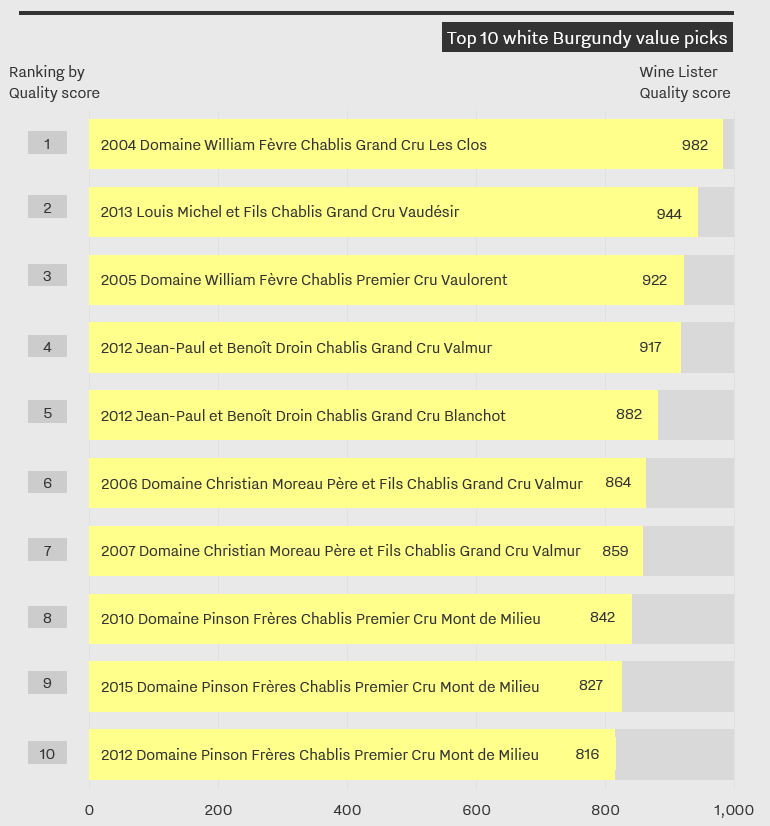
The Burgundian Value Pick with the highest Quality score is in fact a red – Domaine de la Pousse d’Or’s Volnay Premier Cru Clos de la Bousse d’Or 1995. At c.£50 per bottle and a Quality score of 983, it earns the highest Quality score for Volnay, and the third-highest for Burgundy’s 1995 vintage (after Méo-Camuzet’s Vosne Romanée Cros Parantoux and Rousseau’s Chambertin Grand Cru, priced at £1,046 and £1,448 respectively). Any lucky owners of the Clos de la Bousse d’Or 1995 should open and enjoy it now. Wine Lister partner critic, Jancis Robinson, puts its drinking window between 2006 and 2019.
With daily en primeur release alerts and offers for the new 2017 vintage filling our inboxes, the “Bordeaux buzz” at this time of year is undeniable. However, Bordeaux’s popularity does not end with en primeur, as we prove with results of the last quarter’s trading volumes.
Wine Lister uses figures collated by the Wine Market Journal from sales at the world’s major auction houses to calculate incremental increases in four-quarter trading volumes – in this case, January-December 2017 versus April 2017-March 2018. Auction volumes contribute towards Wine Lister Economics scores, allowing us to measure the liquidity of each wine.
The five wines showing the biggest increases in trading volumes between these two periods all hail from Bordeaux. Indeed, such is the case for the top 20 auction volume increases, with the exception of brand royalty, Dom Perignon (in 10th place).
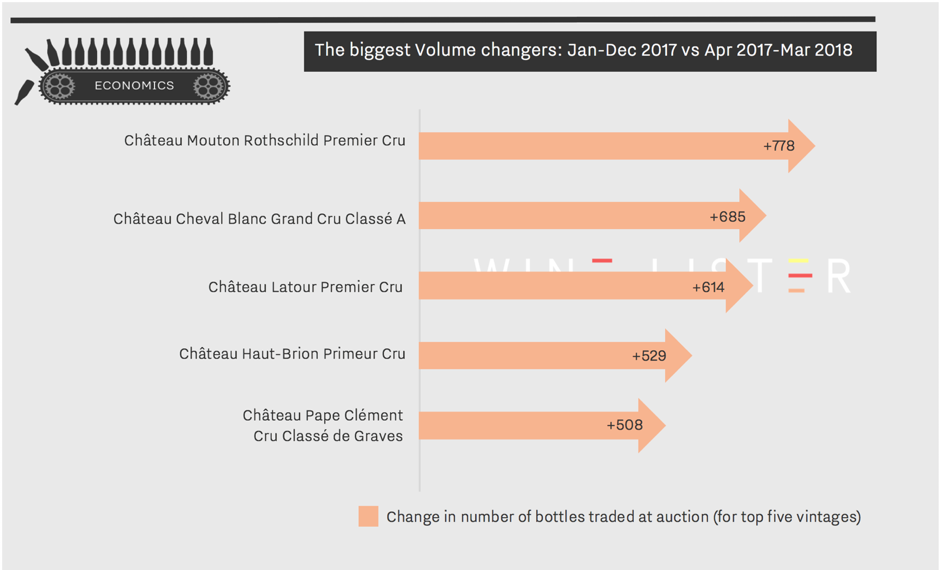
The wine experiencing the biggest increase in trading volumes is Mouton Rothschild, with 778 additional bottles traded. It has the highest Economics score of the five (956) and a compound annual growth rate (CAGR) of 11.3%. Kicking off the first growth releases of 2017 vintages this week, Mouton Rothschild’s 2017 UK release price sits 17% below last year’s at £360 per bottle.
In second place is right bank powerhouse, Cheval Blanc, whose trading volume increased by 685 bottles with the addition of the most recent quarter’s figures. Though second for incremental change, its total trading volume is at least 30% smaller than any of the left bank first growths.
Latour and Haut-Brion come in third and fourth place, both with 12% trading increases of 614 and 529 respectively.
Finally, trades of Pape Clément keep the Pessac-Léognan property’s red in the top five for trade increases for a consecutive quarter, with 506 more bottles traded in the current period. Despite dropping four places since last quarter’s auction volume results, Pape Clément still achieves the highest proportional change of all five wines at the top, with a 27% trading volume increase.
In this week’s top five, we take a break from June’s Bordeaux bias on the vinous calendar to look at the rising prices of Tuscany’s top wines.
However, there’s no escaping Bordeaux with Tuscany’s most expensive wine, since Masseto is distributed through the Place de Bordeaux. With tiny quantities available to purchase via the Place each year – average annual production is 32,000 bottles – Masseto’s price of £511 per bottle makes it well over a third more expensive than the rest of this weeks’ top five, and also the second-most expensive Italian wine on Wine Lister (beaten only by Giacomo Conterno’s Barolo Monfortino Riserva).
Masseto also achieves the group’s best Brand score (977), the result of featuring in the highest number of the world’s top restaurants (24%) and being over 2.5 times more popular than any of the other four. The chart below confirms a strong relationship between Brand score and price for these wines, with Masseto’s formidable brand strength playing a key role in its high price.

At £367 per bottle, Soldera Case Basse Sangiovese takes the second spot. It achieves the highest Quality and Economics scores of the five (976 and 957 respectively). With an impressive three-year compound annual growth rate (CAGR) of 18.4% – by far the highest of the group – and having added 7.3% to its value over the past six months, Soldera Case Basse continues to cement its position as Tuscany’s second-most expensive wine, and close the gap on Masseto.
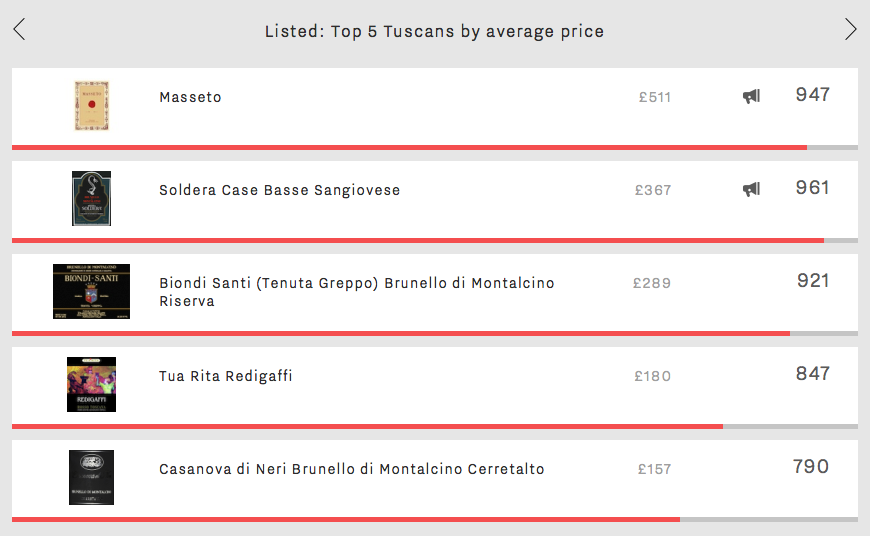
Two Brunellos feature amongst Tuscany’s most expensive wines: Biondi Santi’s Brunello Riserva (£289) and Casanova di Neri’s Brunello Cerretalto (£157). Whilst Biondi Santi Brunello Riserva’s appearance might be expected, considering its heritage, the fact that Casanova di Neri Cerretalto is amongst Tuscany’s most expensive wines might be more of a surprise, indicating that Riserva status alone does not currently guarantee higher prices than straight Brunellos.
Rounding out the five is Tuscany’s fourth-most expensive wine and the group’s second 100% merlot – Tua Rita’s Redigaffi. At an average price of £180 per bottle, it is over 2.5 times cheaper than its varietal companion in the group, Masseto.
D’Issan 2017 released at €42 ex-négociant (10% down on 2016), with a UK RRP of £42.85 (also 10% down on 2016), with a lower Quality score: 768 (vs 898).
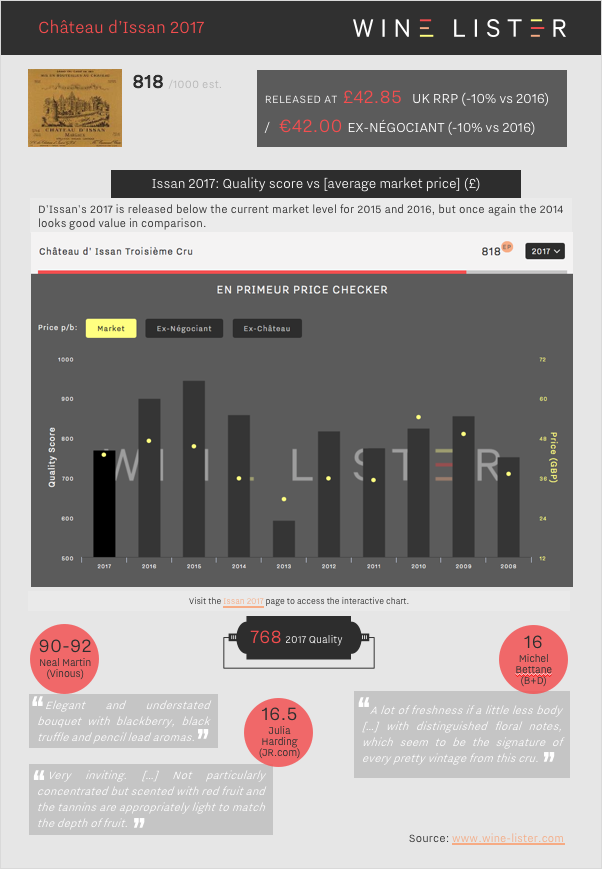
You can download the slide here: Wine Lister Factsheet D’Issan 2017












